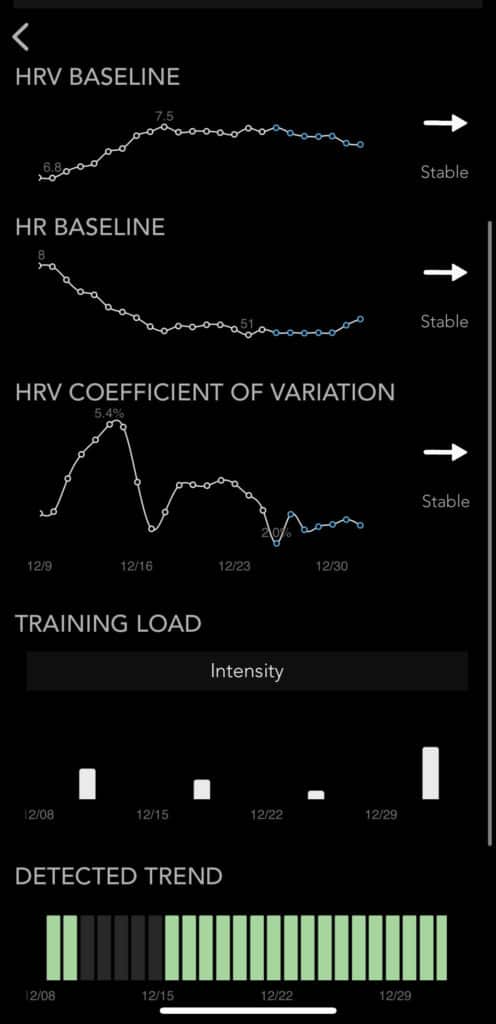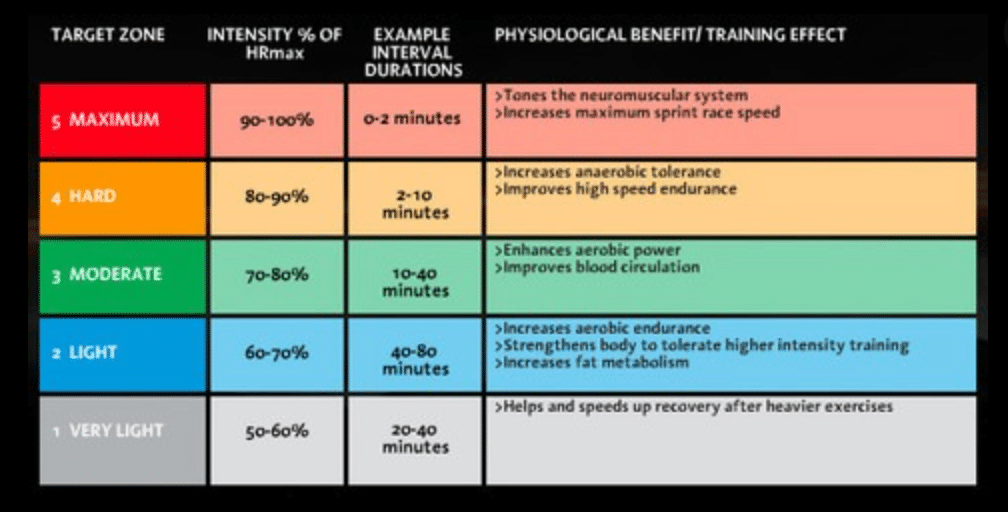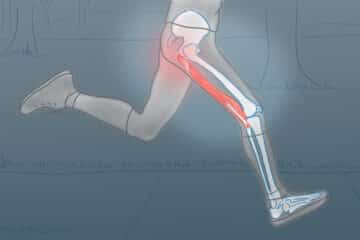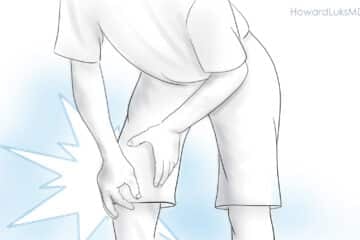
Most all elite endurance athletes and their coaches utilize a polarized training program. Most untrained or casual runners do not use a polarized training program. Are elite runners and their trainers wrong? Or is it us… the average runner?
Most runners run too fast on their slow days and too slow on their fast days. Most of the folks I see running out on the trails are out of breath or pushing hard enough that I hear them breathing before I hear their footsteps.
Do you have a heart rate (HR) of 150+ as soon as you hit your stride? Are you proud of hitting a HR of 188 during your runs every day? This post is for you!

Let’s face it. The average runner is not well coached or trained. We feel like we know what our body can do, and we head out on the road or trail to try and accomplish our goals. We are not well versed in load management. Many do not know what their resting heart rate or HRV response to their training program is. Unfortunately, most average runners are stuck in a “moderate-intensity trap.” Being stuck at this intensity means that we are not training to maximize endurance, resilence or speed.
Most runners run too fast on their slow days
Most average runners train too fast. Except, of course, their “fast” runs — which are often too slow. Many runners have heart rates that are too high during their long-run efforts. This has consequences. For those of you trying to train for distance… you’ve probably noticed that it is challenging to push yourself to a new distance goal, and you become range-bound. Your physiology has a lot to do with this.
We have by now all heard of cytokines and interleukins. These are chemicals in our blood that our body produces in response to disease or any other stressors. Running can be one of those stressors. Run too fast, and your IL-6 levels will rise. Exhaust your glycogen stores, and your IL-6 levels will also increase. IL-6 is an inflammatory mediator, and it will influence your ability to perform and manage long runs and recover consistently. Consistent low-intensity training modulates the IL-6 response and improves your resilience and endurance.

Run slow to run far… or fast. Yes, 80/20 polarized training is right for you!
Is running too fast each day terrible for us? Well… if your heart rate is too high to accomplish that pace, then yes. What’s your goal in running? To become healthier, yes, running fast every day is not in your best interest. Is your goal to podium in an event coming up next year, then —Yes, running fast each day is not in your best interest either.
But… I don’t run too fast? Are you sure? Can you hear yourself breathing? Can you run and breathe easily through your nose? Can you sing a song or talk to a buddy without having to stop to catch your breath? You’re probably running too fast.
Using breathing or the ability to talk is a very rough proxy for effort. You’ll see why it pays off to consider using a heart rate strap as we explore further.
Runners who run too fast too often find themselves having difficulty recovering from a typical run, and they also have difficulty increasing their distance or overall training volume. If you monitor your HRV, you will start to see a dip in your HRV and a rise in your resting HR too often. Your body isn’t happy. Overreaching or worse, overtraining are rearing their ugly head. Overtraining is incredibly challenging to overcome.
If you do not monitor your heart-rate variability (HRV), I strongly suggest that you start. Apps such as HRV4Training make it very easy. Your HRV reflects your level of internal/external stressors. Your parasympathetic nervous system is the soothing portion of the autonomic nervous system. If the stressors in your system start to overwhelm your ability to recover, it will be affected by a decrease in your HRV and an increase in your resting heart rate. We have written a deep dive into HRV and how to use it as a good proxy for your training adaptations.

Moreover, as I have written elsewhere– most runners’ injuries are training errors. Running too fast, too often, is a setup for an overuse injury. The HRV4Training app has a useful guide to show you how you are adapting to your training regimen and load. Some overuse injuries to the upper hamstrings, patella tendon, and achilles tendon can set you back 12 months or more. Avoidance is your best strategy with these types of injuries.
Most all elite athletes in all endurance sports use polarized training. There’s a reason. It works. Dr. Steven Seiler and Dr. Inigio San Milan have helped lay the groundwork for the research that witnessed the popularity of “polarized” training. We have recorded a few podcasts with Dr. San Milan that you can find here.
What is polarized or 80/20 training?
Polarized training has been the most popular method of training the world’s elite endurance athletes for decades. At its core, polarized training involves doing most of your training at a low intensity. 80% of your training to be exact. That intensity is measured in terms of your lactate levels, heart rate, or heart rate zones. While some will rely on lactic acid testing and metabolic testing in labs to precisely identify training zones… for the average runner, heart rate zones work very well. Your heart rate for low-intensity training may be lower or higher than your peers. This is why we will discuss the importance of understanding your heart rate or training zones.
Heart rate zones

Zone 2 training is the “base” of polarized training
“There is no such thing as an overnight breakthrough. You only see the world-record marathon time, or Tour de France winners do so with miraculous times. What you don’t see is the weeks, months, and sometimes years of quiet, smart, and measured efforts—all building toward the goal.” Dr. Steven Seiler
First off… Zone 2 training is “hard.” Why? Because it’s annoying. Because you’re running much slower than you think you’re capable of running. Perhaps worse… even if you commit to zone 2 training, it’s going to take 6 months before you start to see the benefits. It takes a long time to alter our mitochondrial physiology.
How do we determine when we are training appropriately? One very common method is to use a percentage of your heart rate reserve. 70% of my heart rate “reserve” is my goal for my Zone 2 aerobic efforts.
How to determine your aerobic training zone.
Let’s say you choose to use approximately 70% of your heart rate reserve.. here’s the formula. 70% of your heart rate reserve added to your resting heart rate (so your aerobic threshold would be 0.7*(HR max — HR at rest) + HR at rest. In my case, 0.7*(178–48)+48 = 131 beats per minute).
When I first started training at this HR, it was silly. I was running 12-minute miles and walking many hills. In time I was running 10-minute miles with a HR under 120. I was unlucky enough to hit my maximum heart rate on a few trail events. Formulas to determine your maximum heart rate are often wrong… but may serve as a reasonable estimate to get you started. 220 minus your age is listed on the CDC website to determine your maximum heart rate. That would assign me a HRmax of 162. 16 beats off from my actual maximum heart rate.
Why polarized training is effective
Face it… anaerobic, lactic acid threshold, and VO2 max training is sexier than Zone 2 training. The runs are harder, more painful, and leave us feeling that we accomplished more than we did running for 90 minutes at a heart rate of 125. With anaerobic intervals and VO2 max work, you see the changes faster, and far too many assume that this is all they need to do.
After nearly 8 months (I’m 58 years old) of 80/20 polarized training, I was able to run 9:20 miles with a HR of 128. Furthermore, I can run farther, have little or no pain, and feel great at the end of each run.
Why does Zone 2 or base training take so long to result in these changes? Your physiology. Your mitochondria, your muscles’ metabolic machinery all take a long time to adapt to this new training method.

With anaerobic or higher zone training, you’re looking at your heart rate and other parameters that adjust much more quickly to training. Again, higher HR work is sexier.
Zone 2 training is hard.. it is boring… and many might not believe in its benefits when they see no changes 3-4 months into it. Keep going — it’s going to happen.
How do you do polarized training and why you need a heart rate monitor…
I can run with a HR of 150 and feel great. I don’t feel short of breath, I cannot hear my breathing, and I can chat with my running buddies. But that is way above my aerobic threshold and approaching my lactic acid threshold. Does it matter? Yes.. because we need to consider the physiological responses that are occurring in each zone. With aerobic base training, you train your mitochondria to rely more on fat metabolism vs. glucose metabolism. You are improving your mitochondrial flexibility- a sign of healthy mitochondrial function, and you are slowly increasing the number of mitochondria you have in your slow-twitch muscles. Well-trained aerobic athletes have small droplets of fats next to their mitochondria to serve as an energy source. Less well-trained folks have them, too… but for complicated reasons, we cannot utilize them for energy. Changing our metabolic physiology takes a long time.
Heart rate monitors keep us honest. Try not to rely on your average heart rate for a long run. If you are crossing over your upper limit of Zone 2 –your metabolic machinery is switching over to burn more glucose. It will then take a while for that physiology to revert back when your heart rate recovers. Try to stay within Zone 2 the entire time.

The benefits of polarized training
Polarized training was developed to help elite athletes build a tremendous aerobic base. You can only build sound structures on top of a strong foundation as in construction. Have faith that those who have trained some of the top elite aerobic athletes in the world know what they are doing.
Polarized training will build resilience, endurance, stamina, and speed. It will fine-tune your metabolic machinery to enable you to perform at whatever distance you train for. The time will come to layer on your sprints, hill repeats, Fartleks, and so on… just give it time.
This post was on my list of articles to write for a long while, and Dr. Marco Altini’s post on his experience with 80-20 training was the impetus to get this done finally. You can read his post here.













I have recently found my way into HRV. By the way, I am using the free Kubios HRV app on my phone and the HRV Standard on my PC. The HRV Standard even gives you the training zones, which are pretty damn close to those in your article. Just load a training file and you can see how stressful an easy session is. I sometimes retest HRV after some hours to see how I am recovering. This is very, very interesting. On a crappy day, I jog/walk in Zone 1 to see that, by the afternoon, my HRV numbers are way higher than in the morning, showing me that “recovery runs” are real. So far, I like it a lot. I know it’s going to take a year or so, but heck, I had been training with running power for half a year just to do my worst race ever. Disappointing! Now I run for fitness, not for anything else.